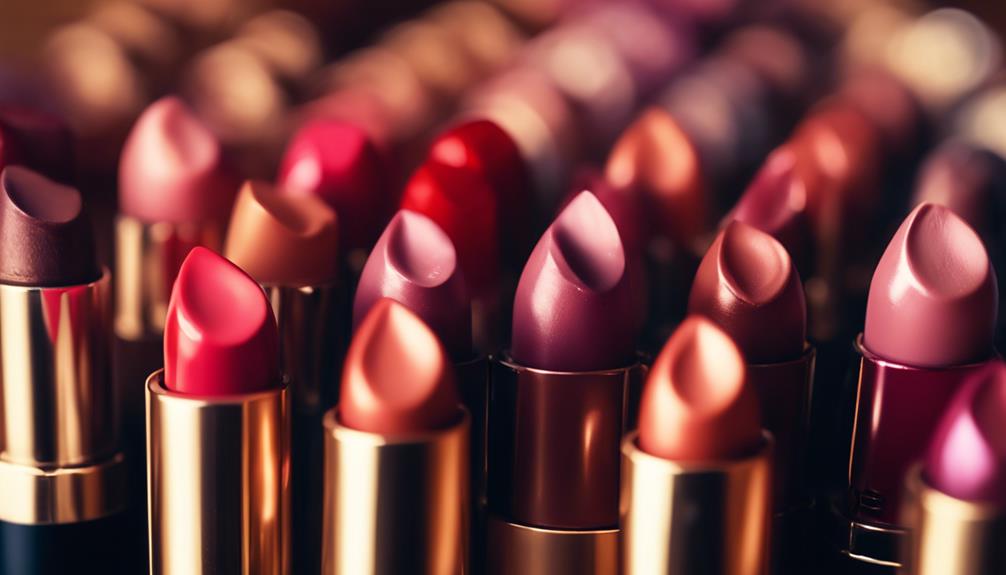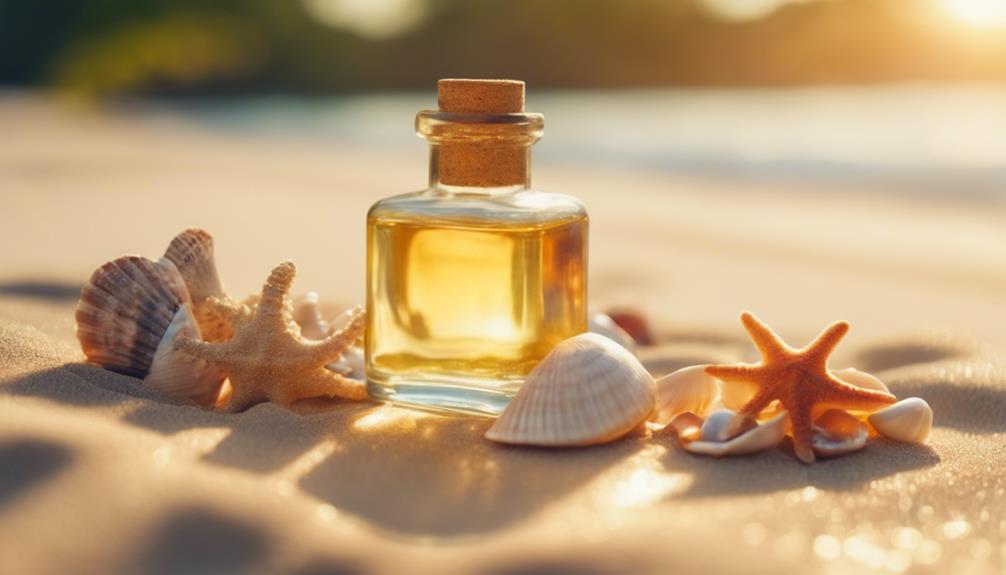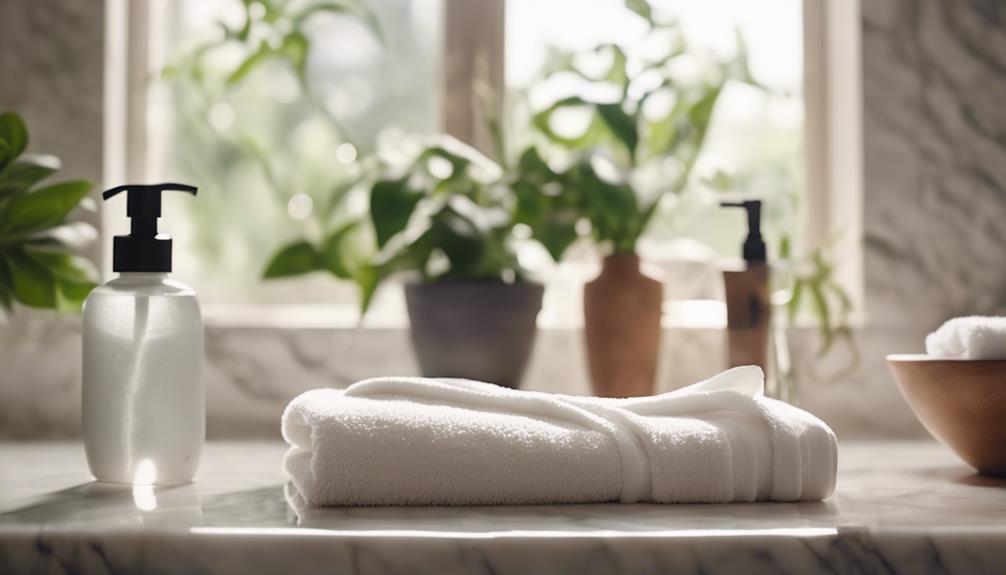Discovering lipsticks that illuminate your tan skin can transform your look. Focus on rich, warm shades like coral, peach, and deep nudes to enhance your natural glow. Creamy formulas, like Revlon's Brazilian Tan, are excellent for hydration, while matte options from Black Radiance provide long-lasting color. Don't forget to test shades in natural light for the best match. Consider nourishing ingredients like shea butter to keep your lips soft and beautiful. With so many options available, you'll find the perfect lipstick to boost your confidence and style. Stick around to explore even more fabulous choices!
Key Takeaways
- Choose rich warm tones like coral and peach to enhance the natural glow of tan skin.
- Opt for creamy finishes for hydration or long-wearing matte formulas to maintain vibrant lips throughout the day.
- Test shades in natural light to ensure they complement your undertones, whether warm or neutral.
- Look for nourishing ingredients like Shea Butter and Murumuru Butter to keep lips moisturized and healthy.
Key Considerations for Selection
When selecting lipsticks for tan skin, you should focus on identifying your undertones to find the most flattering shades.
If you have warm undertones, opt for coral, peach, and golden hues that enhance your complexion. On the other hand, cool undertones pair well with berries and pinks, creating a beautiful contrast. If you're unsure, neutral undertones allow you to experiment with both warm and cool shades.
Besides undertones, consider the lipstick finish and texture preferences—creamy formulas provide hydration, while matte options offer long-lasting wear.
Ultimately, testing shades in natural light helps guarantee you choose colors that truly complement your tan skin, making your selection process more effective and enjoyable.
Top Lipstick Recommendations
For tan skin, choosing the right lipstick can elevate your look, and here are some top recommendations that suit your complexion beautifully.
| Lipstick Product | Key Features |
|---|---|
| wet n wild Mega Last High-Shine Lipstick Pinky Ring | Affordable, buildable, infused with Murumuru Butter |
| Revlon Super Lustrous Lipstick in Brazilian Tan 672 | Creamy, 80 conditioning ingredients, 72 shades available |
| Black Radiance Perfect Tone Matte Liquid Lipstick – Go Nude | Moisture-rich, intense color payoff, long-wearing |
These shades will enhance your natural glow, ensuring you feel confident and stylish. Don't hesitate to explore these options and find the perfect match for your tan skin!
Application and Wear Techniques
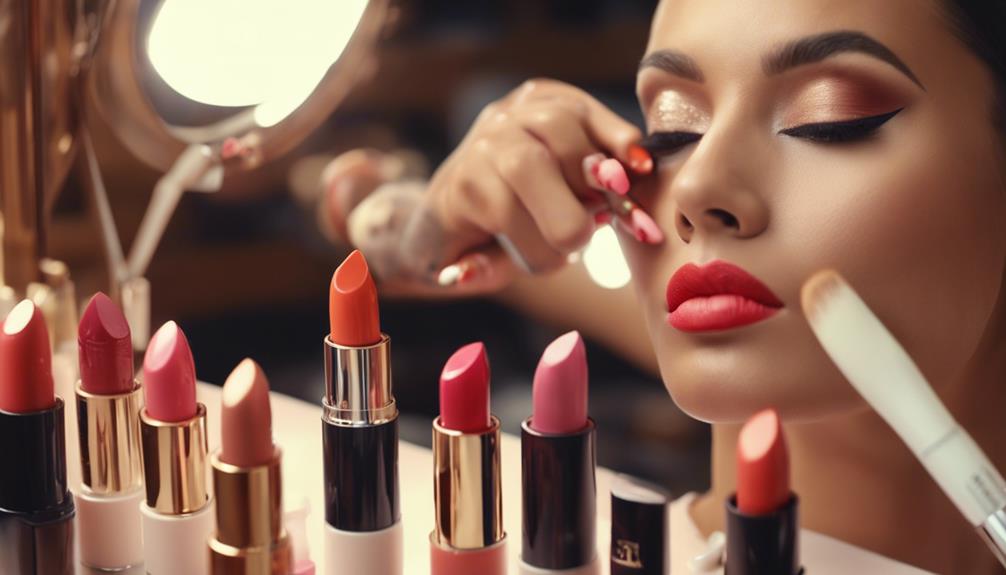
Exfoliating your lips beforehand guarantees a smooth canvas for lipstick application, enhancing both the finish and wear.
After exfoliation, apply a lip primer to keep your color vibrant and prevent feathering.
When you choose your lipstick, opt for rich shades that flatter your tan skin tone.
For added shine and hydration, layer your lipstick with a gloss.
Always test your lipstick in natural light to verify you love the true color.
If you're using long-wear products, remember to shake them before application for ideal results.
Long-Wearing Formulas
Long-wearing formulas are essential for maintaining a vibrant lip look throughout the day without constant touch-ups. These lipsticks, especially matte liquid options, provide extended wear that keeps your color intact, preventing smudging and fading.
Look for transfer-resistant choices that guarantee your lips stay flawless from morning to night. Hydrating elements like Shea Butter not only enhance comfort but also keep your lips feeling nourished.
Buildable coverage lets you customize the intensity, matching your mood or occasion. Brands like Maybelline and Black Radiance offer excellent long-wearing options that cater to tan skin, guaranteeing you find the perfect shade while enjoying lasting performance.
Opt for these formulas, and you'll enjoy beautiful lips that withstand the day's demands.
Ethical Lipstick Choices
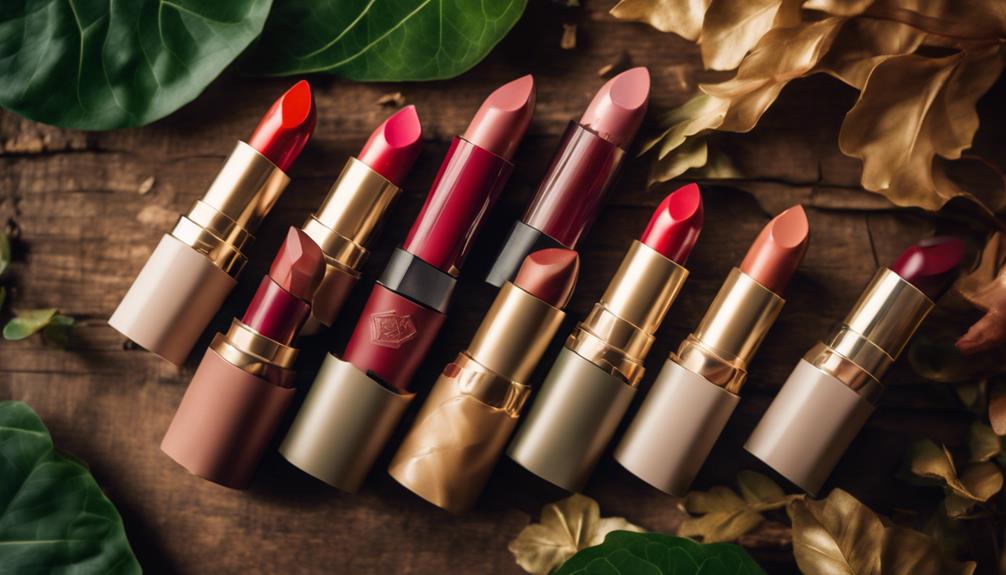
Choosing ethical lipstick options not only enhances your beauty routine but also supports important values like animal welfare and environmental sustainability.
When selecting lipsticks, look for cruelty-free brands that don't test on animals. Vegan formulations are another great choice, ensuring no animal-derived ingredients are involved.
Transparency in ingredient sourcing builds trust between you and the brand, allowing you to make informed decisions. Additionally, opt for eco-friendly packaging to minimize your environmental impact.
Benefits of Nourishing Ingredients
Incorporating nourishing ingredients into your lipstick not only enhances your beauty routine but also provides essential care for your lips.
Look for lipsticks infused with Shea Butter, which deeply moisturizes and prevents chapping, ensuring a smooth application.
Ingredients like Murumuru Butter and seed oils boost lip health, offering hydration and comfort throughout the day.
Aloe Vera and Chamomile deliver antioxidant benefits, calming and soothing your lips.
Additionally, coconut and castor oils create a silky texture, making application feel luxurious.
These nourishing elements not only help maintain your lips' softness and elasticity but also keep your lipstick looking fresh longer.
Shades That Enhance Tan Skin
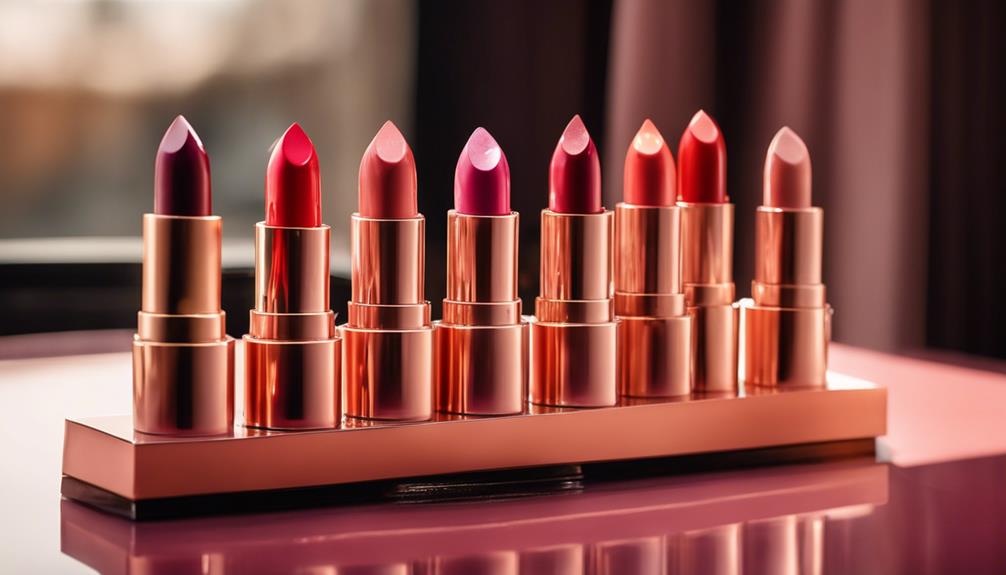
To truly make your tan skin pop, opt for shades that bring out the warmth and vibrancy of your complexion. Rich, warm tones like coral, peach, and deep nudes enhance your natural glow. You'll want to steer clear of overly light shades that can wash you out. Instead, choose shades that complement your undertones, whether they're warm or neutral.
Here's a quick reference table for your lipstick selection:
| Warm Shades | Neutral Shades | Berry Shades |
|---|---|---|
| Coral | Warm Beige | Raspberry |
| Peach | Mauve | Plum |
| Terracotta | Rosewood | Deep Cherry |
These shades will not only enhance your tan skin but also elevate your overall look!
Affordable Lipstick Options
Looking for budget-friendly lipstick options that don't compromise on quality? You're in luck!
Drugstore brands like wet n wild and Revlon offer fantastic choices for tan skin without breaking the bank.
For a creamy finish, try Revlon Super Lustrous Lipstick in Brazilian Tan or the hydrating Maybelline Color Sensational in Nude Lust.
If you prefer a matte look, the Black Radiance Perfect Tone Matte Liquid Lipstick in Go Nude is a great pick.
Explore value sets like the MAEPEOR Matte Liquid Lipstick kit for a variety of shades at a lower price.
Always check customer reviews to guarantee you're making a smart purchase.
With these options, you can rock beautiful lip colors while staying within budget!
Frequently Asked Questions
How Can I Determine My Skin Undertone?
To determine your skin undertone, check your veins—blue indicates cool, green suggests warm. You can also try the white paper test; if your skin looks yellow, you're warm. Experiment with jewelry to see what complements you best.
What Are the Best Ways to Store Lipstick?
To store lipstick effectively, keep it in a cool, dry place away from direct sunlight. Avoid extreme temperatures, and consider using a makeup organizer to prevent damage and guarantee easy access to your favorite shades.
How Often Should I Replace My Lipstick?
Like a garden's bloom, your lipstick needs renewal. You should replace it every 1-2 years, or sooner if it smells off or changes texture. Fresh lipstick guarantees vibrant color and healthy application every time.
Can I Mix Different Lipstick Shades?
Absolutely, you can mix different lipstick shades! Experimenting with combinations allows you to create unique colors that suit your style. Just blend carefully to achieve the desired look, and don't forget to test the final shade!
What Tools Do I Need for Applying Lipstick?
Applying lipstick's like painting a masterpiece. You'll need a good lip brush for precision, a lip liner to define, and a primer for lasting power. Don't forget tissue for blotting and a mirror for perfect application!
Conclusion
Now that you know how to choose the perfect lipstick for your tan skin, it's time to experiment!
Remember, the right shade can truly enhance your glow and reflect your personality. The theory that color can impact your mood holds truth; wearing a shade you love can boost your confidence and brighten your day.
So, don't hesitate to try out different hues and finishes—it's all about finding what makes you feel fabulous.
Let your lips shine!
